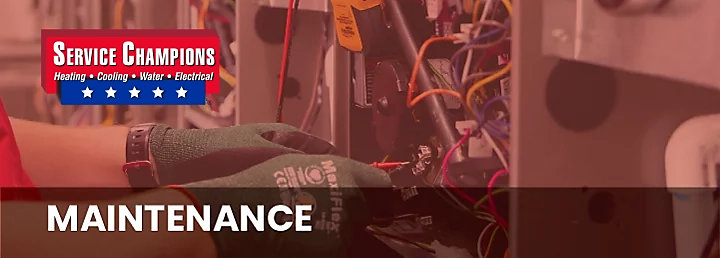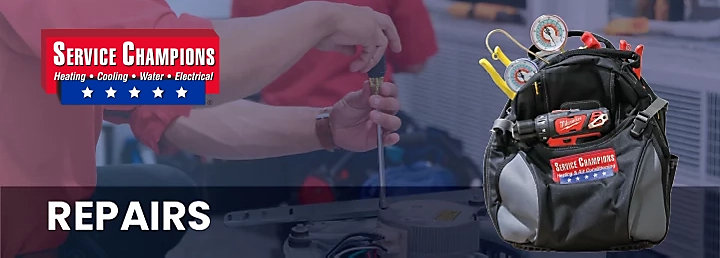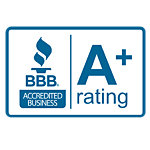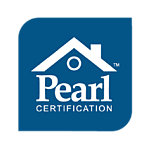INDUSTRY TERMINOLOGY
From A To Z, Here’s How to Translate Air Conditioning & Heating Jargon
Air Conditioning & Heating Industry Terminology Explained
If you have questions about your specific system, contact us today.
A
A – Coil
This heat exchanger depends on two coils, placed diagonally and then connected in the middle. The result is a coil that looks like the letter “A”.
AC
This electric current rapidly changes its direction of flow. See also DC (Direct Current).
AC or DC
These abbreviations stand for Alternating Current and Direct Current, and represent forms of electrical circuiting.
ACCA
Air Conditioning Contractors of America.
Acoustical
A derivative of the word “acoustic”. When a system is acoustical, it makes or conducts sound well.
AFUE
This yearly measurement is an efficiency test of the conversion of fuel to energy by a furnace. A high rating on an AFUE test indicates a good furnace. Service Champions technicians can do AFUE tests.
AGA
Abbreviation for American Gas Association, Inc.
Air Cleaner
Also known as an air filter, this equipment removes dust, debris, and other particles floating in the air. When air moves through the air cleaner, these particles are caught.
Air Conditioner
This system is usually placed outside the home, and controls the humidity, ventilation, and temperature of the air inside.
Airflow Volume
This is a measurement of an air conditioner’s output. Airflow volume is calculated by measuring the cubic feet per minute that the air conditioner circulates.
Air Handler
This piece of the air conditioning system regulates and directs air throughout the ductwork, spreading heated or cooled air through the home.
ARI
Air Conditioning & Refrigeration Institute.
ASHRAE
American Society of Heating, Refrigeration and Air Conditioning Engineer
B
BTU
British thermal unit. The standard of measurement used to guage the amount of heat required to raise the temperature of one pound of water by one degree (Fahrenheit).
BTUh
Equal to about 1.06 kilojoules, this measurement is taken in heating and cooling when assessing the power output of an air conditioner or furnace. BTU measurement can also be taken by the hour, and are known as BTUh.
Burner
This piece of a furnace conducts heat using electric or gas fuel.
Burner (sealed combustion)
A piece of a furnace that conducts heat using the air outside of the system.
Burner Orifice
The piece of the burner that inputs gas. The gas is then mixed with air and used as fuel.
C
Capacity
The capability of a heating or cooling system to fill a required space.
Celsius
The metric scale of temperature. When measured on water, the freezing point is 0°C, and the boiling point is 100°C. Conversion from Celsius to Fahrenheit is as follows: Multiply by 9, then divide by 5, then add 32.
CFM – (Cubic Feet per Minute)
The airflow rate in an air conditioning system.
Charge
The process of adding refrigerant to an air conditioning system. Refrigerant is stored in a sealed system and aids in the overall cooling factor. Refrigerant moves from the indoor evaporator to the outdoor condenser and then back to the indoor evaporator.
Compressor
The piece of equipment pumps refrigerant through a sealed system.
Condensate
The process of a chemical that changes from its vapor form to its liquid form.
Condenser coil (or outdoor coil)
Also known as an outdoor coil. This piece of the air conditioner removes heat from refrigerant in vapor form. When the heat is removed, the refrigerant becomes liquid and moves back to the inside of the machine.
Condenser Fan
This piece of equipment cools the condenser by blowing air on it.
Contactor
This piece of equipment cycles electrical current. A contactor switches on and off; connecting and breaking an electrical current.
Crankcase Heater
A piece of equipment that maintains the vapor form of refrigerant in the crankcase part of the system. By heating the crankcase oil to a higher temperature than the coldest part of the system, refrigerant remains in its vapor form.
D
Damper
A plate that opens and closes to regulate air flow through the ductwork system.
DC – (Direct Current)
This electric current travels in a direct route. See also AC (Alternating Current).
Defrost
The process in which frost buildup from the outdoor coil is removed. This usually takes place when the weather is cold and the air conditioner is not in use.
Degreeday
Measurement of required for an amount of space. It is equal to the outside temperature minus 65°F.
Dehumidifier
This piece of equipment extracts humidity from the air. It cools air to the point where water turns from vapor to liquid form and then removes the liquid.
Diffuser
Placed over ductwork, this part separates air with vanes going in differing directions.
DOE
Department of Energy
Downflow Furnace
This type of furnace processes air from top to bottom.
Drain Pan
This part catches any condensate left in the machine. Not all machines need a drain pan.
Dry Bulb Temperature
A measurement of heat intensity independently of humidity. A dry bulb thermometer takes this measurement.
Dry Bulb Thermometer
An device that measures air temperature independently of humidity.
Ductwork
This system of pipes transports heat from the central air conditioning or heating system to the rest of the building.
DX
This refers to the expansion of refrigerant. This process conducts heat.
E
EER
This is a measurement of the cooling capacity of an air conditioner.
BTUh: electrical watt input.
EPA
This Federal Agency encourages the use of eco–friendly, non–pollutant, and energy efficient equipment in every sector, including heating and air-conditioning.
Evaporator Coil (or Indoor Coil)
Also known as the indoor coil, this piece of equipment removes heat and humidity from the air inside the building.
Expansion Valve
This part measures the pressure and temperature of refrigerant.
F
Fahrenheit
This temperature scale is used mostly in the United States. When measured in water, the freezing point is 32°F and the boiling point is 212°F. Conversion to the Celsius temperature scale, use the equation below: Deduct 32, then multiply by 5, then divide by 9.
Fan
This piece of equipment uses motion to create an air current.
Filter
This part removes particles of dust and other debris from the air. (See MERV Rating).
Flue
This part of the equipment vents out exhaust gases.
Furnace
This heating system uses fuel to produce heat for a building.
Fuse
This part protects against overcurrent. When too much electricity is running, the fuse melts and breaks the current.
H
Heat Exchanger
The part of the system allows heat to be transferred from the hot parts of the machine to the cold parts of the machine.
Heat Gain
This is a total amount of heat an area receives from all heat conducting machines including furnaces, appliances, lighting, respiration and solar energy.
Heat Loss
This is a measurement of the rate heat escapes from the inside of a building to the outside of the building.
Heat Pump
This compressor cycles hot or cold air to the building.
Heat Transfer
The process where heat moves from one area to another.
Heating Coil
This part of the system conducts heat.
Hertz
The measurement of electrical energy per second. Standard frequency is 6-Hertz.
HSPF – (Heating Seasonal Performance Factor)
The measurement of heat efficiency over the period of a heating season.
Humidifier
The sensor which measures and regulates humidity.
Humidistat
The sensor which measures and regulates humidity.
Humidity
The measurement of moisture volume in the air.
Humidity, Absolute
The ratio of humidity between saturated and non–saturated air. It is taken by measuring the grams of water vapor in 1 cubic meter of air.
Humidity, Relative
The ratio of current humidity to the humidity if the air were 100% saturated.
HVAC – (Heating, Ventilating and Air Conditioning)
M
Media
The part of an air filter which traps dust particles, debris and other impurities in the air. This can be made of fiberglass, polyester, dog hair, blue/green, and charcoal, among other materials.
MERV rating (Minimum Efficiency Reporting Value)
Numbered from 1 to 16, this measurement gives the efficiency value of an air filter.
P
Package Unit
This smaller heating or cooling unit is used for residential purposes and is usually located on the roof or in the attic of a house. It can be moved without disconnecting any refrigerant lines.
PSI – (Pounds per square inch)
PSIA – (Pounds per square inch, absolute)
PSIG – (Pounds per square inch, gauge)
PVC – (Polyvinyl Chloride)
This plastic is used more frequently in buildings.
R
Reciprocating Compressor
This piece of equipment works directly with the crankshaft to highly pressurize gases.
Refrigerant
The chemical used to cool air. It expands to vapor form, gathering hot air, and then contracts to liquid form to cool the air.
Refrigerant Charge
The required amount of refrigerant in a system.
S
SEER
The measurement of seasonal or annual heating or cooling efficiency. This rating is used nationwide and is a good indicator of operating cost.
Self Contained System
(See Package Unit)
Sensible Heat
The type of heat that affects the temperature of a substance.
Sensor
The piece of equipment that measures and regulates changes. Air conditioning and heating sensors measure the air temperature and humidity among other things.
Setpoint
Part of the thermostat, this is the indicator of the desired indoor temperature.
Spine Fin
The aluminum outdoor coil made of tiny spines. This creates a greater surface area, which improves heat exchange efficiency. This technology is patented.
Split System
The combination of an outdoor unit and an indoor unit. This is the most common type of system.
T
Thermostat
This system monitors and regulates a heating or cooling system.
Ton
The measurement of the cooling capacity of a heating or cooling system. A ton of energy can melt a ton of ice in a 24-hour period.
Two-stage (cooling and heating)
An air conditioner designed to operate on high and low settings during different weather. The high setting is used during more extreme weather, and the low setting is used during more moderate weather. This type of air conditioner is in use for a longer period of time, and produces a balanced temperature.
TXV – Thermostatic Expansion Valve
The piece of equipment that meters the flow of liquid refrigerant into the evaporator while also measuring the vapor refrigerant leaving the evaporator.
V
Vacuum
A pressure below atmospheric pressure. 30 inches Mercury (periodic symbol “Hg”) is a perfect vacuum.
Variable speed motor(s)
A type of fan that adjust speed according to the need of operation. This contributes to efficiency and performance of the machine.
Volt
Measurement of electrical force given to the electrons in an electric circuit.
Voltage
The force that pushes electrical current along wires and cables.
Contact us 24/7
ZERO CONTACT SERVICE. PUTTING SAFETY FIRST.
Service Champions is committed to maintaining a safe and healthy environment for our clients and team members.
It is important for you to feel confident when our technicians are arriving at your home.
We have implemented increased hygiene routines, including hand washing and sanitizing before and after each client visit.
Additionally, our technicians are avoiding typical contact with our clients, like shaking hands.
Every Service Champions team member in your home will be equipped with the following:
-
Shoe Covers
-
Face Masks
-
Antibacterial Soap
-
Disposable Latex Gloves
-
Disinfecting Wipes
We will remain open full-time to service and maintain our clients’ heating, air conditioning and indoor air quality needs 7 days a week.
Take advantage of these great savings!

$88 Furnace Tune-Up
& Water Heater Safety Inspection

$88 Furnace Tune-Up
Promo Code: FURNACETUNEUP88
Expires: Apr 30, 2024
When you don’t get regular maintenance performed on your furnace, you’ll most likely end up having to do an expensive repairs you didn’t see coming. The best way to avoid unpleasant surprises and badly-timed breakdowns is to schedule an annual Furnace Tune-Up. Your system will last longer with regular air conditioner maintenance and you’ll avoid the costs and hassles of early replacement of your system. With Service Champions, maintenance is very affordable and worry-free.
Mention this offer prior to scheduling service. Cannot be combined with any other offers and discounts. Does not apply to the response fee.

$88 Furnace Tune-Up
Promotion Code: FURNACETUNEUP88
Expires Apr 30, 2024
Description:
When you don’t get regular maintenance performed on your furnace, you’ll most likely end up having to do an expensive repairs you didn’t see coming. The best way to avoid unpleasant surprises and badly-timed breakdowns is to schedule an annual Furnace Tune-Up. Your system will last longer with regular air conditioner maintenance and you’ll avoid the costs and hassles of early replacement of your system. With Service Champions, maintenance is very affordable and worry-free.
Mention this offer prior to scheduling service. Cannot be combined with any other offers and discounts. Does not apply to the response fee.

$45 Off
Furnace or Air Conditioner Repairs

$45 Off
Promo Code: HVAC45
Expires: Apr 30, 2024
If you’re in need of an air conditioner repair, Service Champions is the dependable choice for guaranteed results. When your air conditioner is working poorly – or not at all – our highly-trained technicians will carefully diagnose your A/C system and then recommend the right repair. It’s a secure feeling calling on the top Northern California A/C repair company – you’re protected by our superb guarantee to be trustworthy, on-time and leave you worry-free, or it’s free!
Mention this offer prior to scheduling service. Cannot be combined with any other offers and discounts. Does not apply to the response fee.

$45 Off
Promotion Code: HVAC45
Expires Apr 30, 2024
Description:
If you’re in need of an air conditioner repair, Service Champions is the dependable choice for guaranteed results. When your air conditioner is working poorly – or not at all – our highly-trained technicians will carefully diagnose your A/C system and then recommend the right repair. It’s a secure feeling calling on the top Northern California A/C repair company – you’re protected by our superb guarantee to be trustworthy, on-time and leave you worry-free, or it’s free!
Mention this offer prior to scheduling service. Cannot be combined with any other offers and discounts. Does not apply to the response fee.







